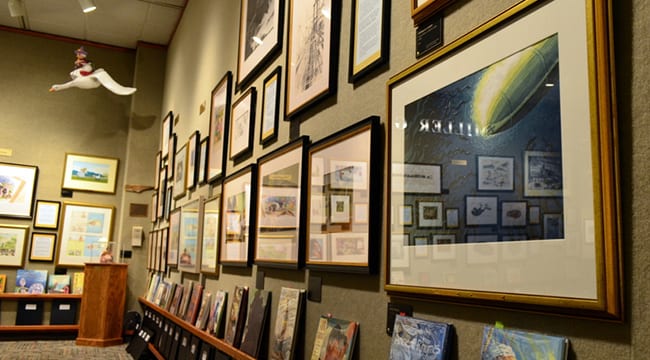Art, Art Everywhere: Mazza Museum Behind the Scenes
It is the most diverse collection of original artwork by children’s book illustrators in the world, and unless you’re not familiar with the University of Findlay, you already know that the Mazza Museum is a place of joy and wonder delighting young and old alike. What most people might not be knowledgeable about, however, is what goes on behind the scenes. Where does all of that wonderful art come from? How often is it changed out, and what kind of an undertaking is that? What does it take to make a magical museum like the Mazza hum?
After the recent fall 2017 Mazza Weekend Conference, Ben Sapp and Kerry Teeple, Director and Deputy Director of the Mazza Museum respectively, explained that it takes a lot of careful foresight and dedication to manage the upwards of 3000 pieces of art constantly on display at the Museum, not to mention the more than 1000 works housed in sleeves in the climate-controlled vault where they’re kept when not displayed, and the myriad of pieces out in various traveling exhibits. One Museum gallery is changed every three months and everything in the Museum gets switched out once a year, which typically takes around a week. That way, the displays remain fresh and there is always new material to see. “We want people who come back frequently to see different things,” said Sapp. The Museum tries to time any changes around events that are set to take place. But there has to be art to change out, and the endeavor of procuring it is just as interesting as how it’s moved around the Museum.
According to Sapp and Teeple, there are three main opportunities that can lead to acquiring art for the Museum: conferences, study tours and direct conversation. Before their visit, illustrators are given the opportunity to donate or sell their artwork in order for it to be on display prior to their conference. Artists will sometimes bring pieces with them to donate during their visit, and other times start the conversation themselves about donating their art. Often, the artists invited to the conference are seasoned enough to be aware of the Museum’s desire to acquire the art of its speakers, so they broach the subject first. They can also choose to donate or sell after the conference.
Study tours involve visiting the illustrators where they live and work. “We see so many illustrators during that time,” Teeple said. In fact, on the most recent tour to the west coast Portland and Seattle, to be exact 26 illustrators were visited in one week. Teeple added that there is often a conversation started on these tours about acquiring artwork, and that it’s an opportunity to see the entire process and even to form relationships with up and coming artists. “It’s always fun to watch them flourish,” added Sapp, mentioning further that every visit is different. “And while the visits are a good way to see their work and talk about acquiring, we always respect their livelihood,” he said.
There are times, however, when the direct approach is best. In this case, a certain illustrator might be brought to the Museum’s attention by volunteers, a librarian, or an article in a journal, and the artist will be contacted about acquiring art. Many times, this leads to a conference invitation, as well. This was the case with Jerry Pinkney, an illustrator of many children’s books dating back some fifty years. Pinkney’s art regularly fetches high sales prices, so purchasing seemed out of the equation for the Museum. Pinkney’s illustrations, however, are so loved that a particular donor wanted to help fund a purchase. Pinkney discussed with Sapp what he had available to obtain, but the discussion didn’t lead to any work being exchanged. That is, until around a week later when Pinkney called and explained that he wanted to donate a piece of his recent work focusing on the Underground Railroad. And just like that, art was procured. “Every situation is different,” Sapp said. “And we’re often extremely fortunate.”


Leave a Reply
You must be logged in to post a comment.